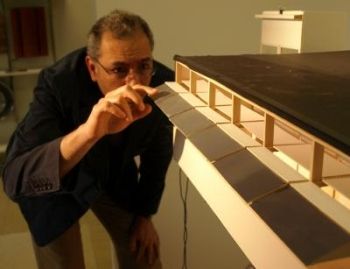
Publisher:
Bonnie King
CONTACT:
Newsroom@Salem-news.com
Advertising:
Adsales@Salem-news.com

~Truth~
~Justice~
~Peace~
TJP
May-11-2009 10:48

 TweetFollow @OregonNews
TweetFollow @OregonNews
How About Green Renovations in Existing U.S. Schools?
Salem-News.comHow about green renovations in existing U.S. schools? UO architecture professor's Green Classroom Toolbox aims to put student performance into the planning
 Ihab Elzeyadi, professor of architecture at the University of Oregon, looks at a model in his lab. The impact of exterior changes to block bright light and reduce energy consumption is being measured by a light meter inside the model. Photo by Jim Barlow |
(EUGENE, Ore.) - Going green with new construction is a good idea, but what about renovating existing structures? Like, say, the 20 billion square feet of existing U.S. public schools, 40 percent of which have 15 million students in poor environmental conditions?
These are questions at the heart of research by Ihab M.K. Elzeyadi, a professor of architecture at the University of Oregon.
Elzeyadi has completed the first stage of creating a Green Classroom Toolbox for architects and planners to use in their energy retrofits and modernization plans. His second of three presentations in a three-month period will be May 13 during Solar 2009, the 38th national meeting of the American Solar Energy Society, in Buffalo, N.Y.
"We believe our findings can help plan classroom designs and retrofits to green our aging schools, which are energy and environmentally unconscious," said Elzeyadi, who also is a participating faculty member in the Oregon Built Environment & Sustainable Technologies Center (Oregon BEST), an independent, nonprofit organization established by the Oregon Legislature in 2007.
"Under the American Recovery and Reinvestment Act of 2009, school districts will have access to federal funding to modernize and green their schools," he said. "Our work provides school designers and officials with the needed guidelines to direct this process the right way. It will act as a decision support system."
At the 2009 Leadership in Architectural Research conference, which focused on connections between academia and the architecture profession, in San Antonio last month, Elzeyadi detailed the Green Classroom Toolbox for the first time. In Buffalo, he will hit on its highlights and discuss recent case studies involving work with the Oregon Health and Science University in Portland, Ore.
"I am alarmed by the state of our schools," he said. "We have 20 billion square feet of existing space that are in worse conditions than our prisons, and this is where students are expected to learn." In San Antonio, he noted how new-construction planning often incorporates green ideas to reduce energy use and carbon footprints, but "existing classrooms have been largely ignored." Also missing, he said, are data on direct impacts human performance and student learning.
"We need to be able to understand not only how buildings can conserve energy but also what impacts these efforts have on humans inside them," he said. "If we can have two sides of the story, then we can have triple benefits for people, profit and planet."
The toolbox includes a checklist of 20 best practices, pared down from a series of meetings in Portland, Salem and Eugene, all in Oregon, where 24 representatives of K-12 schools, architects, engineers and facility managers generated 128 ideas. Elzeyadi's team surveyed literature on health impacts of going green and then ran simulations on a prototypical elementary school building. In addition to the checklist, the toolbox features a prioritization guide that also provides comparative analyses and a guide that links best practices to findings on health and performance.
"You can't drastically change poor early design decisions, but our analysis shows that some minimal retrofits in the classroom can have drastic impacts," Elzeyadi said.
The project began almost two years ago after Elzeyadi collaborated on a school project. "I found there had been lots of guidelines and best practices about new construction but not existing structures. I thought it was time to do that for retrofits." Before joining the UO faculty in 2001, he had worked as a project manager for the Heschong Mahone Group of Sacramento, Calif., where, he contributed to studies on daylighting effects on buildings and human performance.
The first step of constructing the toolbox was funded by seed grants from the American Institute of Architects and the UO School of Architecture and Allied Arts. The toolbox provides evidence-based renovation guidelines for schools in the three Oregon cities, but on-going work aims to expand the contents to cover new areas in different climates and locations.
The news stage of the research is being partially supported by Elzeyadi's selection as the first recipient of a $10,000 MulvannyG2 Faculty Excellence Research Award created in 2008 by MulvannyG2, an architectural company based in Bellevue, Wash.
Elzeyadi also will discuss his work June 22 during the three-day Passive and Low Energy Architecture Conference in Quebec City, Canada.
Source: University of Oregon
Articles for May 10, 2009 | Articles for May 11, 2009 | Articles for May 12, 2009



Quick Links
DINING
Willamette UniversityGoudy Commons Cafe
Dine on the Queen
Willamette Queen Sternwheeler
MUST SEE SALEM
Oregon Capitol ToursCapitol History Gateway
Willamette River Ride
Willamette Queen Sternwheeler
Historic Home Tours:
Deepwood Museum
The Bush House
Gaiety Hollow Garden
AUCTIONS - APPRAISALS
Auction Masters & AppraisalsCONSTRUCTION SERVICES
Roofing and ContractingSheridan, Ore.
ONLINE SHOPPING
Special Occasion DressesAdvertise with Salem-News
Contact:AdSales@Salem-News.com


Terms of Service | Privacy Policy
All comments and messages are approved by people and self promotional links or unacceptable comments are denied.
[Return to Top]
©2025 Salem-News.com. All opinions expressed in this article are those of the author and do not necessarily reflect those of Salem-News.com.